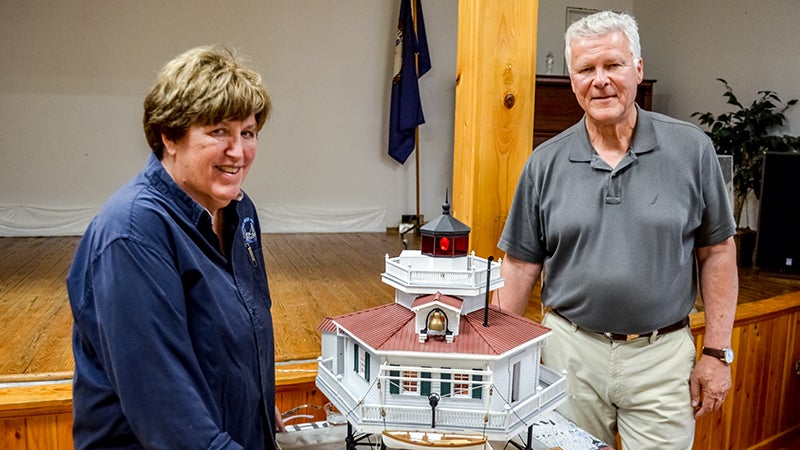Shining a light on forgotten screwpiles
Published 9:32 pm Thursday, May 17, 2018

- Suffolk River Heritage chairman Karla Smith and board member Larry Saint beside the model of the Nansemond River Lighthouse that Saint made in painstaking detail over 18 months based on the original lighthouse plans.
After years of in-depth archival research, interviews and photographs, the Suffolk River Heritage Foundation presented its latest book to more than 55 people at the River Talk held Tuesday evening at the C.E.&H. Ruritan Hall in Eclipse.
Co-authors Karla Smith and Larry Saint presented “Screwpiles: The Forgotten Lighthouses,” a pictorial history on the unique lighthouses that illuminated riverways in southeastern Virginia, northeastern North Carolina and southern Maryland in the 19th century before the Civil War.
The two worked with fellow Heritage members John Sheally II and Phyllis Speidell to uncover even more information than they bargained for, then compiled their findings into a 200-plus-page hardcover book with gorgeous photography and illustrations.
Their findings ranged from the earliest lighthouses in the country to other maritime nuggets like time balls, which were used to allow mariners to set their chronometers daily to Greenwich Mean Time. The device inspired the Times Square Ball in New York City.
Smith and Saint joked that they should have named the book “I Didn’t Know That.”
“This is the hardest project I’d ever done,” Smith said Tuesday evening. “Larry would bring up so much archival research and would bring it by the pound, not by the ream. We had about 100 times more information than we could put in the book.”
There were 42 screwpile lighthouses built on the Chesapeake Bay between 1850 and 1900, more than anywhere else in the world and based on an English design, according to marinersmuseum.org. Seven iron legs were screwed into the bottom of the bay in a hexagonal pattern. Cottages were built on top of the iron foundation for the keepers, with lights placed at the very top of the structures.
Sailboats gave way to steam-powered travel, and these screwpiles were needed for vessels to safely navigate busy waterways like the James River, which allowed for 15 to 20 vessel landings in Richmond per day in 1860, according to Saint.
“Between 1813 and 1963, some 300 steamboats ran out of Baltimore, as many as 140 out of Washington and up to 150 out of Norfolk,” according to the book. “Early on, groundings were an issue on the bay and its many rivers and creeks. As steamboat traffic increased, so did the need for accurate aids to navigation.”
Saint explained how he and the rest of the team gained an immense appreciation of the technology and craftsmanship in these lighthouses, which were cheaper and faster to build than conventional designs.
The lights themselves were marvels. French physicist Augustin-Jean Fresnel invented the Fresnel lens in 1822, which focused 85 percent of a lamp’s light, per the book. The U.S. Lighthouse Board adopted them in 1851, from the largest first-order Fresnel lenses approximately 8.5 feet tall at 12,800 pounds to the sixth-order variety used in the James River lighthouses that were just 17 inches tall and 220 pounds.
“I may overuse the term precisely here, but that’s on purpose,” Saint said Tuesday evening. “The theory, design and making of the lenses required precision. The angles of each of those prisms surrounding the light had to be precisely designed. The mold that was used to create each prism had to be precisely formed so that when the glass was poured into it, everything was at the correct angle.”
The men and women that manned these lighthouses had rigid schedules daily. The Hooper Strait Lighthouse at the Chesapeake Bay Maritime Museum in St. Michaels, Md. specified lightkeeper duties like attending to the light and fog bell, boat handling and daily maintenance like scrubbing, cleaning and painting.
These keepers were vulnerable to the Civil War and also the elements. They were especially vulnerable to ice floes in shoal water, like the three original James River lighthouses. Large sheets of ice would pile at the edge of the shoal and hammer against the piles, shaking the station. Lighthouse tenders sometimes couldn’t paddle out to resupply the keepers for days or weeks because of the ice.
But the keepers were nevertheless steadfast, like Juliet Nichols of the Angel Island Lighthouse near San Francisco. On July 2, 1906, a thick fog set in and her fog bell striking mechanism failed. The bell’s ring pattern was crucial for ship captains to check their charts.
Alone and desperate to safeguard ferry traffic, Nichols manually struck the bell every 15 seconds for 20 hours and 22 minutes.
“That’s the kind of dedication that existed among light house keepers,” Saint said.
Copies of “Screwpiles: The Forgotten Lighthouses” can be purchased for $40. Sales will help fund a digital archive for Suffolk River Heritage research and other books like “The River Binds Us.” Search “Screwpiles: The Forgotten Lighthouses” on Amazon.com or visit suffolk-river-heritage.org.





